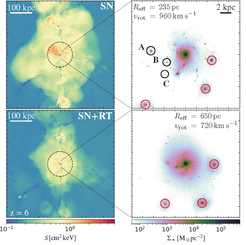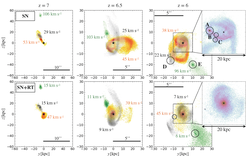The hidden satellites of the first massive galaxies and quasars
Quasars are some of the brightest objects in the Universe, powered by supermassive black holes as they swallow prodigious amounts of interstellar gas to grow to masses about a billion times that of the Sun. The luminous output of quasars can be so high that they often outshine entire galaxies, remaining within the reach of telescopes out to extreme distances. The most distant quasars currently known lie close to 13 billion light-years away and their light as observed today was emitted when the Universe was only a few hundred million years old, less than 10% its current age. The properties of the galaxies and cosmic environments in which quasars evolve remain very poorly understood, however.
Quasar animation
This animation shows the typical cosmological environment of bright quasars. The quasar host galaxy, which is about ten times smaller than the Milky Way, is continuously fed by a network of filaments that bring in large gas masses. The black hole at the centre continues to grow and powers powerful galactic outflows.
Sophisticated hydrodynamic simulations performed on large supercomputers are able to model key processes ranging from gas cooling, star formation and the production of hot gas through supernova explosions to black hole growth. These `mock’ or simulated Universes can be used to study the evolution of the first quasars lighting up the early Universe. According to these simulations, quasars form at the centre of massive galaxies with stellar masses on the order of 100 billion Suns. The quasar host galaxy, which is about ten times smaller than the Milky Way, is continuously fed by a network of filaments that bring in large gas masses, ensuring sustained star formation and black hole growth in the galactic nucleus, while the quasar launches powerful galactic outflows (see animation). Another key prediction of such simulations is that an anomalously large population of massive satellite galaxies should surround the massive galaxies hosting the first quasars.

Fig. 2 shows the distribution of hot gas in a region hundreds of thousands of light years across around the massive galaxy, in the simulation without stellar radiation (top) and with stellar radiation (bottom). The right-hand panel of Fig. 2 zooms-in on the massive galaxy itself, showing the distribution of stars within the central regions. Here again we can see the effects of stellar radiation, which appears to not only result in a larger, more `puffed-up’ galaxy (bottom) but also in a smaller number of stellar clumps around the galaxy.
Most previous simulations have excluded the effect of radiation from young stars on interstellar gas, which can potentially alter the properties of both the quasar host galaxy and its satellites. The importance of stellar radiation for the evolution of these massive systems has therefore remained unknown. An international team of researchers from the Max Planck Institute for Astrophysics, the Centre de Rechèrche Astrophysique de Lyon (France) and Yonsei University (Seoul, South Korea) therefore set out to explore the effect of `switching-on’ stellar radiation on the evolution of a simulated quasar host galaxy. In order to successfully model stellar radiation, it was necessary to perform fully radiation-hydrodynamic, cosmological simulations, or in other words, to model both the hydrodynamic evolution of interstellar and intergalactic gas as well as to model the propagation of radiation from each individual stellar population in the simulation.
Remarkably, the new simulations show that stellar radiation can have significant consequences for the evolution and the structure of massive galaxies such as those hosting the first bright quasars. Stellar radiation has the counter-intuitive effect of reducing the amount of hot gas at cosmic scales. This is because, as stars form, their radiation heats up interstellar gas in their vicinity preventing it from collapsing and forming stars in turn. But since a reduced star formation implies a smaller number of supernova explosions, stellar radiation indirectly results in lower amounts of hot gas. Stellar radiation not only reduces the total number of stars, but also the number of stellar “clumps” around the galaxy (see Fig. 2). Why is that and what is the nature of the stellar clumps that exist in the simulation without stellar radiation but seemingly go away when stellar light is `turned-on’?

Fig. 3 shows a time-sequence of three galaxies that end up as satellites of the massive quasar-host galaxy without (top) and with (bottom) stellar radiation. The satellites are strongly disrupted by tidal forces as they orbit around the massive central but often survive in the form of compact stellar clumps if radiation is neglected, while they are mostly destroyed if stellar radiation is included.
In order to answer this question, the researchers selected different galaxies within the simulation starting from a time when their virtual Universe was only about 600 million years old and traced them forward in time. They found that many of these galaxies end up as satellites around the massive quasar host galaxy, but that while many satellites survive as they orbit the central galaxy in the simulation without stellar radiation, these same satellites are sometimes completely destroyed in the simulation with stellar radiation.
This means that by preventing star formation, stellar radiation results in less massive galaxies, more vulnerable to destruction by strong tidal forces as they pass close to their massive central galaxy (for example note the evolution of the galaxy shown in green in Fig. 3). Stellar radiation thus indirectly results in the early demise of satellite galaxies around quasar-host galaxies in the early Universe, making them appear to have fewer neighbours than if stellar radiation was neglected. The simulations predict that the galaxies hosting the first quasars should be surrounded by a large number of streams of stripped stellar material, the remnants of destroyed satellites.













